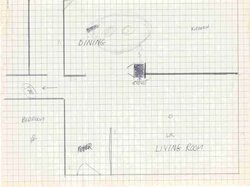I live in a 1720 square foot ranch style house. It's a simple rectangle, with the "public" areas of the house grouped at one end of the house (kitchen, family room, living room, foyer). This area measures about 900 square feet and the stove will be sited on a short 3' wall perpendicular to wall that partially divides the kitchen/family room from the living room/foyer. So this relatively open area ought to be warm and comfortable to all corners.
On the other hand, the remaining 800 square feet of the house could be described as "closed to warm air". This second part of the house (around 800 square feet) consists of a straight hallway about 20' long, with the 3 bedrooms and 2 bathrooms opening left and right off the hallway. The two back bedrooms are "way back there", so to speak.
I'm planning to locate a free standing gas stove somewhat forward of center in the "public" area of the house. It has the specs to heat around 1600-1700 square feet. So I'm pretty sure it will do a great job in the more open "public" areas of the house. What I'm wondering is how much warmth can be expected to drift down the hallway and turn corners into the bedrooms and bathrooms.
I don't know whether it's relevent or not, but I'll mention that the front of the stove, where most of the heat is emitted, will be facing the hallway. And I don't anticipate attaching a blower to the stove.
On the other hand, the remaining 800 square feet of the house could be described as "closed to warm air". This second part of the house (around 800 square feet) consists of a straight hallway about 20' long, with the 3 bedrooms and 2 bathrooms opening left and right off the hallway. The two back bedrooms are "way back there", so to speak.
I'm planning to locate a free standing gas stove somewhat forward of center in the "public" area of the house. It has the specs to heat around 1600-1700 square feet. So I'm pretty sure it will do a great job in the more open "public" areas of the house. What I'm wondering is how much warmth can be expected to drift down the hallway and turn corners into the bedrooms and bathrooms.
I don't know whether it's relevent or not, but I'll mention that the front of the stove, where most of the heat is emitted, will be facing the hallway. And I don't anticipate attaching a blower to the stove.



